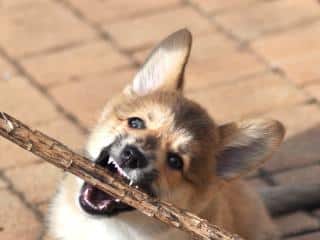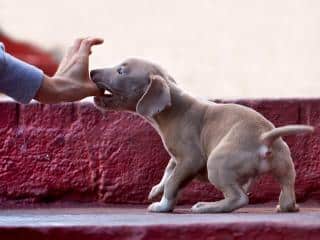

Chewing and biting is crucial for a puppy. The thing is, they need to learn how to control the strength of their jaw and teeth so they don’t pose a threat when they grow up.
Here’s how to nail this essential learning.
 Biting eases their toothache. At a month and a half old, a puppy has 28 milk teeth that will be replaced by 42 permanent teeth.
Biting eases their toothache. At a month and a half old, a puppy has 28 milk teeth that will be replaced by 42 permanent teeth.Bite inhibition, what’s that mean?
→ Puppies learn to control their biting. This is known as bite inhibition, and it’s a crucial learning phase in their development.
In the first weeks of their life, puppies socialize. They learn to hold back their biting while playing with siblings. If a puppy bites too hard, its brother or sister yells, retaliates or stops playing. The puppy then understands that it went too far.
Did you know?
The mother dog puts her puppy back in its place by pressing her mouth down against its neck, forcing it to submit.
A puppy’s biting can be observed up until 8 months of age. When you go to pick it up from the breeder, it’ll be between 2 and 3 months old. As a result, you have to continue this vital learning.
 Never push away the puppy. It’ll indeed interpret the gesture as an invitation to play and it’ll get even more excited.
Never push away the puppy. It’ll indeed interpret the gesture as an invitation to play and it’ll get even more excited.If a puppy was separated from its mother too early or if the mother was inexperienced, learning inhibited biting can be more difficult.
It takes time and consistency for a puppy to learn to measure the strength of its bite. This learning is crucial, because if one day your dog bites someone or another animal violently, everyone will pay the price.
Have toys, such as rope or buffalo hide bones, for your puppy to chew. Keep out of reach anything they might wreck. Puppies aren’t yet privy to what’s theirs and what isn’t. They’re busy exploring world, don’t forget. If nipping persists beyond their first birthday, consider a consulting a behaviorist. You might have a hyperactive puppy on your hands.
Food for thought:
“Life is a short-term contract with continuous learning!” François-Joseph Goasdoue